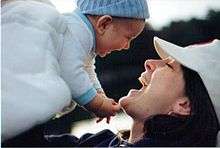Maternal bond
A maternal bond is the relationship between a mother and her child. While typically associated with pregnancy and childbirth, a maternal bond may also develop in cases where the child is unrelated, such as an adoption.



Both physical and emotional factors influence the mother-child bonding process. In separation anxiety disorder a child becomes fearful and nervous when away from a loved one, usually a parent or other caregiver. New mothers do not always experience instant love toward their child. Instead, the bond can strengthen over time. Bonds can take hours, days, weeks, or months to develop.[1]
Pregnancy
The maternal bond between a woman and her biological child usually begins to develop during pregnancy. The pregnant female adapts her lifestyle to suit the needs of the developing infant. At around 18 to 25 weeks, the mother begins to feel the fetus moving. Similar to seeing her child for the first time in an ultrasound scan, this experience typically leads the mother to feel more attached to her child.
The developing fetus has some awareness of the mother's heartbeat and voice and has the ability to respond to touch or movement. By the seventh month of pregnancy, two-thirds of women report a strong maternal bond with their unborn child.[2]
Some mothers who did not want the pregnancy may not have a close relationship with the child.[3] They are more likely to suffer from post-partum depression or other mental health problems and less likely to breast feed.[3]
Childbirth
Childbirth is an experience that can strengthen the mother and child bond. Factors such as a traumatic birth, the mother's childhood, medical stress, lack of support and the influence of a spouse or partner can weaken the bond.
Emotional bonding theory first appeared in the mid-1970s,[4] and by the 1980s had become an accepted phenomenon. Soon, the process became analyzed and scrutinized to the point of creating another term – poor bonding.
Oxytocin
Production of oxytocin during childbirth and lactation increases parasympathetic activity. Thus, anxiety is theoretically reduced. Maternal oxytocin circulation is said to predispose women to bond and show bonding behavior,[5][6] although this has been disputed.[7]
Breastfeeding is also strongly believed to foster the bond, via touch, response and mutual gazing.[8]
Moral side effects
A 2014 study claimed that oxytocin promotes dishonesty when the outcome favors the closely bonded groups to which an individual belongs. A real-world example of this effect can be seen when parents lie about their address to gain admission to better schools for their children.[9]
Maternal separation anxiety
Beginning at 9–10 months of age when infants begin to crawl and then when they begin to walk around 12 months of age, they begin to develop capacities to physically explore the world away from their mother.[10] These capacities bring with them separation anxiety as the infant becomes more vulnerable away from mother. This newly acquired motor development parallels infants' intellectual curiosity, cognitive and language development as they begin to point and name, and jointly attend with mothers to their environment beginning by 9–10 months. Most parents welcome these explorations and this increased independence. However, in the context of maternal depression, trauma or disturbed bonding in her own early life, some mothers have significant difficulty in tolerating the exploration and-or the infant's anxiety.[11]
This anxiety increases when infants and toddlers feel threatened or socially reference their mothers for reassurance. Research claimed out that mothers, for example, with histories of violence-exposure and post-traumatic stress show less activity in the medial prefrontal cortex, a brain area that helps to temper and contextualize fear responses, and thus are likely unable to extinguish their own fear response upon watching a videotaped mother-toddler separation scene in a magnetic resonance imaging scanner.[12]
Inevitably, children who have rarely been separated from their mother become anxious when separated for extended periods. This is most commonly experienced when starting to attend school. Every child suffers to some extent.
Later in life, this anxiety can reoccur if mothers have to leave their family unit to work. In both cases, the child's anxiety (and that of the parents) can be reduced by priming, i.e. preparing the child for the experience prior to its occurrence and by creating and maintaining dialogue and connection between the absent parent and child during the separation.
See also
Footnotes
- Winkler, Jiří (2000). "Utváření mateřského pouta v těhotenství" [Development of the maternal bond during pregnancy]. Časopis Lékařů Českých (in Czech). 139 (1): 5–8. PMID 10750284.
- Winkler J (2000). "[Development of the maternal bond during pregnancy]". Cas. Lek. Cesk. (in Czech). 139 (1): 5–8. PMID 10750284.
- "Family Planning – Healthy People 2020". Retrieved 2011-08-18.
Which cites:
- Logan C, Holcombe E, Manlove J, et al. (May 2007). "The consequences of unintended childbearing: A white paper" (PDF). Washington: Child Trends, Inc. Archived from the original (PDF) on July 2, 2010. Retrieved March 3, 2009. Cite journal requires
|journal=(help) - Cheng D, Schwarz E, Douglas E, et al. (March 2009). "Unintended pregnancy and associated maternal preconception, prenatal and postpartum behaviors". Contraception. 79 (3): 194–8. doi:10.1016/j.contraception.2008.09.009. PMID 19185672.
- Kost K, Landry D, Darroch J (Mar–Apr 1998). "Predicting maternal behaviors during pregnancy: Does intention status matter?". Fam Plann Perspectives. 30 (2): 79–88. doi:10.2307/2991664. PMID 9561873.
- D’Angelo, D, Colley Gilbert B, Rochat R; et al. (Sep–Oct 2004). "Differences between mistimed and unwanted pregnancies among women who have live births". Perspect Sex Reprod Health. 36 (5): 192–7. doi:10.1111/j.1931-2393.2004.tb00022.x.CS1 maint: multiple names: authors list (link)
- Logan C, Holcombe E, Manlove J, et al. (May 2007). "The consequences of unintended childbearing: A white paper" (PDF). Washington: Child Trends, Inc. Archived from the original (PDF) on July 2, 2010. Retrieved March 3, 2009. Cite journal requires
- Spinner, Miriam R. (November 1978). "Maternal-Infant Bonding". Can Fam Physician. 24: 1151–3. PMC 2379718. PMID 21301556.
- Chiras DD (2012). Human Biology (7th ed.). Sudbury, MA: Jones & Bartlett Learning. p. 262. ISBN 978-0-7637-8345-7.
- Human Evolutionary Biology. Cambridge University Press. 2010. p. 282. ISBN 978-1-139-78900-4.
- Fillod, Odile (2014), "Oxytocin as proximal cause of 'maternal instinct': weak science, post-feminism, and the hormones of mystique", in Schmitz, Sigrid; Höppner, Grit (eds.), Gendered neurocultures: feminist and queer perspectives on current brain discourses, challenge GENDER, 2, Wien: Zaglossus, ISBN 9783902902122.CS1 maint: ref=harv (link)
- Else-Quest, NM; Hyde JS; Clark, R (2003-10-01). "Breastfeeding, bonding, and the mother-infant relationship". Merrill-Palmer Quarterly. Retrieved 2008-03-13.CS1 maint: multiple names: authors list (link)
- Shalvia, S.; De Dreu, C. K. W. (Apr 2014). "Oxytocin promotes group-serving dishonesty". Proceedings of the National Academy of Sciences of the United States of America. 111 (15): 5503–5507. doi:10.1073/pnas.1400724111. PMC 3992689. PMID 24706799. Lay summary – BBC News (2 April 2014).
- Schaffer HR (2004). Introducing Child Psychology. Oxford: Blackwell. ISBN 978-0-631-21627-8.
- Pelaez M, Virues-Ortega J, Field TM, Amir-Kisei Y, Schnerch G (2013). Social referencing in infants of mothers with symptoms of depression. Infant Behav Dev, 36(4): 548-56. doi : 0.1016/j.infbeh.2013.05.003. Epub 2013 Jun 14.
- Schechter DS, Moser DA, Paoloni-Giacobino A, Stenz A, Gex-Fabry M, Aue T, Adouan W, Cordero MI, Suardi F, Manini A, Sancho Rossignol A, Merminod G, Ansermet F, Dayer AG, Rusconi Serpa S (epub May 29, 2015). Methylation of NR3C1 is related to maternal PTSD, parenting stress and maternal medial prefrontal cortical activity in response to child separation among mothers with histories of violence exposure. Frontiers in Psychology.}}